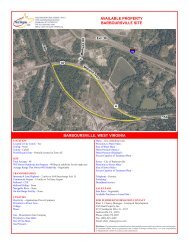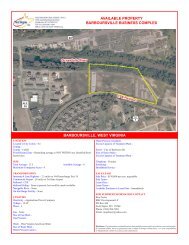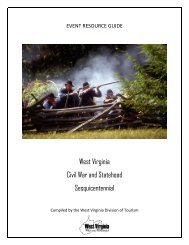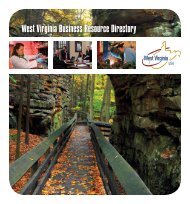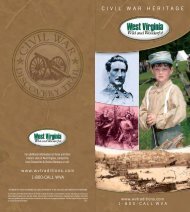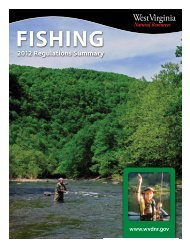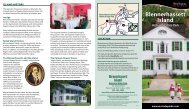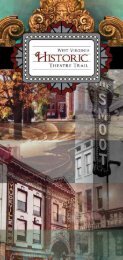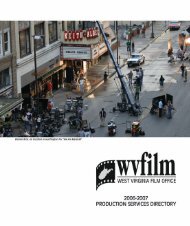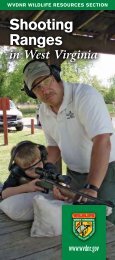State Wildlife Center Brochure - West Virginia Department of ...
State Wildlife Center Brochure - West Virginia Department of ...
State Wildlife Center Brochure - West Virginia Department of ...
- No tags were found...
Create successful ePaper yourself
Turn your PDF publications into a flip-book with our unique Google optimized e-Paper software.
HISTORYAlthough the <strong>Wildlife</strong> <strong>Center</strong> is a modern facility,its roots run deep into the annals <strong>of</strong> wildlifeconservation. In the early 1900s, <strong>West</strong> <strong>Virginia</strong>’swildlife populations were in sharp decline due touncontrolled exploitation and habitat destruction.Conservationists began vigorously promoting gamerefuges as a means <strong>of</strong> protecting diminishing wildlife.The <strong>West</strong> <strong>Virginia</strong> Conservation Commission(forerunner <strong>of</strong> the Division <strong>of</strong> Natural Resources)began purchasing land for game refuges inthe 1920s, using funds derived from the sale <strong>of</strong>hunting licenses. The French Creek Game Farm waspurchased in 1923 and used periodically to penraisevarious species <strong>of</strong> game birds and animalsfor restocking projects for the next 29 years. Thisprogram was discontinued when it was proven tobe biologically unsound. Pen-raised animals do notdevelop survival skills necessary for life in the wild.From its beginning, the Game Farm attracted publiccuriosity. Recognizing its unique recreational andeducational value, the Conservation Commissiondeveloped several native wildlife species displaysfor the general public. These wildlife exhibitsproved to be so popular that in the fall <strong>of</strong> 1926,nearly 6,000 people visited the farm.In 1954, one pair <strong>of</strong> elk and bison were obtainedfrom Oklahoma. Elk and bison, which had previouslyroamed <strong>West</strong> <strong>Virginia</strong>, proved to be major attractions.Other species <strong>of</strong> formerly native wildlife, such asthe mountain lion, timber wolf and river otter, havebeen added over the years. The collection <strong>of</strong> exhibitanimals also includes three non-native wildlifespecies that now occur in our state: the Europeanwild boar, ring-necked pheasant and coyote.An entirely new exhibit area was designed andbuilt beginning in 1984. Funding was obtainedusing matching federal monies from the Land andWater Conservation Fund <strong>of</strong> the U.S. <strong>Department</strong><strong>of</strong> Interior. On September 28, 1986, the new facilitywas dedicated and renamed the <strong>West</strong> <strong>Virginia</strong> <strong>State</strong><strong>Wildlife</strong> <strong>Center</strong>.Jack Mills Jack Mills



